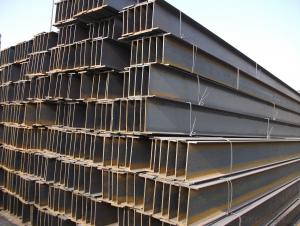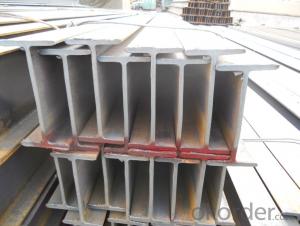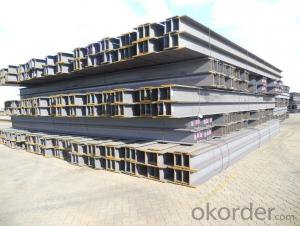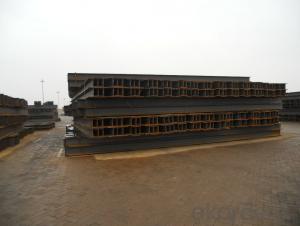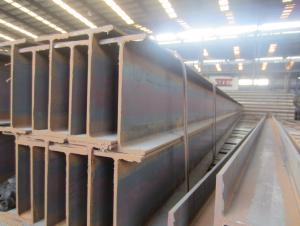Hot Rolled HBeam Steel for Building Structures
- Loading Port:
- Shanghai
- Payment Terms:
- TT OR LC
- Min Order Qty:
- 2000 m.t.
- Supply Capability:
- 10000 m.t./month
OKorder Service Pledge
OKorder Financial Service
You Might Also Like
Product Description:
Specifications of Hot Rolled H-Beam Steel for Building Structures
1. Standard: JIS G3101, SS400(1987),GB700-88, Q235B,EN10034-1993 / EN10025-2004,
HEA100-HEA500,HEB100-HEB500
2. Grade: Q235, SS400 or Equivalent
3. Length: 6m,10m, 12m as following table
4. Invoicing on theoretical weight or actual weight as customer request
5.Payment: TT or L/C
6. Sizes:
SIZE(mm) | DIMENSION (kg/m) |
100*100 | 16.9 |
125*125 | 23.6 |
150*75 | 14 |
150*150 | 31.1 |
148*100 | 20.7 |
198*99 | 17.8 |
200*100 | 20.9 |
248*124 | 25.1 |
250*125 | 29 |
300*150 | 36.7 |
298*149 | 32 |
200*200 | 49.9 |
294*200 | 55.8 |
346*174 | 41.2 |
350*175 | 49.4 |
244*175 | 43.6 |
175*175 | 40.4 |
294*200 | 55.8 |
298*201 | 64.4 |
346*174 | 41.2 |
350*175 | 49.4 |
400*200 | 65.4 |
396*199 | 56.1 |
450*200 | 74.9 |
446*199 | 65.1 |
340*250 | 78.1 |
500*200 | 88.1 |
300*150 | 36.7 |
Usage & Applications of Hot Rolled H-Beam Steel for Building Structures
Commercial building structure ;Pre-engineered buildings; Machinery support structure; Prefabricated structure; Medium scale bridges; Ship-building structure. etc.
Packaging & Delivery of Hot Rolled H-Beam Steel for Building Structures
1. Packing: it is nude packed in bundles by steel wire rod
2. Bundle weight: not more than 3.5MT for bulk vessel; less than 3 MT for container load
3. Marks:
Color marking: There will be color marking on both end of the bundle for the cargo delivered by bulk vessel. That makes it easily to distinguish at the destination port.
Tag mark: there will be tag mark tied up on the bundles. The information usually including supplier logo and name, product name, made in China, shipping marks and other information request by the customer.
If loading by container the marking is not needed, but we will prepare it as customer request.
4. Transportation: the goods are delivered by truck from mill to loading port, the maximum quantity can be loaded is around 40MTs by each truck. If the order quantity cannot reach the full truck loaded, the transportation cost per ton will be little higher than full load.
5. Delivered by container or bulk vessel
Production flow of Hot Rolled H-Beam Steel for Building Structures
Material prepare (billet) —heat up—rough rolling—precision rolling—cooling—packing—storage and transportation
- Q:Can steel H-beams be used for cantilever structures?
- Certainly! Cantilever structures can indeed make use of steel H-beams. These structures are specifically designed to incorporate a projecting beam or member that is supported on just one end, while the other end remains free or unsupported. Steel H-beams are widely employed in the realm of construction due to their remarkable strength and ability to bear substantial loads. They are particularly well-suited for cantilever designs as they offer exceptional structural support, effectively minimizing deflection and ensuring overall stability. Nonetheless, it is imperative to take into account the specific requirements of the cantilever structure. In order to determine the appropriate size and strength of the H-beam necessary to support the desired load and span, it is highly recommended to seek guidance from a structural engineer.
- Q:What are the different design codes and standards applicable to steel H-beams?
- There are several design codes and standards applicable to steel H-beams, which include the American Institute of Steel Construction (AISC) Manual of Steel Construction, Eurocode 3 for steel structures, British Standards (BS) such as BS 5950, and Canadian Standards Association (CSA) standards. These codes and standards provide guidelines for the design, fabrication, and installation of steel H-beams to ensure structural integrity, safety, and performance.
- Q:How can steel H-beams be protected from corrosion?
- Steel H-beams can be protected from corrosion through various methods such as applying a protective coating, galvanizing the beams, or using corrosion inhibitors. These techniques create a barrier between the steel and the corrosive elements, preventing rust formation and extending the lifespan of the H-beams.
- Q:What is the process of galvanizing steel H-beams?
- Galvanizing steel H-beams, also known as galvanization, is the method used to protect them from corrosion and rust. To ensure the adhesion of the zinc coating, the H-beams must first be cleaned to remove dirt, oil, or grease. There are various cleaning methods available, including chemical cleaning, abrasive cleaning, and high-pressure water cleaning. Once the beams are clean, they can be either dipped into a molten zinc bath or sprayed with a zinc-rich coating. This creates a protective layer on the surface of the H-beams through metallurgical bonding, which involves the intermingling of zinc and steel molecules to form a strong bond. After the galvanizing process, the H-beams are cooled and inspected for any defects or irregularities. The thickness, uniformity, and adherence of the zinc coating are checked to ensure they meet the required standards. If necessary, repairs or touch-ups are performed before the beams are deemed ready for use. Galvanized steel H-beams offer several advantages, including increased durability, extended lifespan, and enhanced resistance to corrosion. As a result, they are suitable for a wide range of applications, such as construction, infrastructure, and industrial projects. By undergoing the galvanizing process, steel H-beams are protected against environmental factors, such as moisture, humidity, and exposure to chemicals, ensuring their structural integrity and longevity.
- Q:Are steel H-beams suitable for use in the construction of transportation facilities or stations?
- Yes, steel H-beams are suitable for use in the construction of transportation facilities or stations. Steel H-beams are known for their strength, durability, and load-bearing capabilities, making them an ideal choice for supporting heavy structures such as transportation facilities. They can withstand the weight of vehicles, provide structural stability, and ensure the safety of the infrastructure. Additionally, steel H-beams are versatile and can be easily customized to meet specific design requirements, making them a reliable option for building transportation facilities or stations.
- Q:Can steel H-beams be used for stadium construction?
- Yes, steel H-beams can be used for stadium construction. H-beams are a common structural element used in construction due to their high strength and versatility. They are capable of supporting heavy loads and providing stability to large structures like stadiums. Additionally, steel H-beams offer several advantages such as durability, fire resistance, and the ability to withstand extreme weather conditions. Their use in stadium construction allows for the creation of large open spaces without the need for intermediate columns, providing unobstructed views for spectators. Overall, steel H-beams are an excellent choice for stadium construction due to their structural integrity and suitability for supporting the unique requirements of such large-scale projects.
- Q:What are the different methods of protecting steel H-beams from fire?
- There are several methods of protecting steel H-beams from fire. One common method is applying fire-resistant coatings or intumescent paints, which expand when exposed to heat and create a protective barrier. Another method is encasing the beams in fire-resistant materials such as gypsum board or concrete. Additionally, fireproofing sprays and wraps can be used to provide insulation and delay the effects of heat on the steel beams.
- Q:Can steel H-beams be used for warehouse structures?
- Yes, steel H-beams can be used for warehouse structures. Steel H-beams are widely used in construction due to their strength, durability, and load-bearing capabilities, making them suitable for supporting the weight and maintaining the integrity of a warehouse structure.
- Q:What are the design considerations for steel H-beams in cold climates?
- To guarantee the structural integrity and effectiveness of steel H-beams in cold climates, there are several vital factors that need to be considered during the design process. These considerations are as follows: 1. Material Selection: It is crucial to select the appropriate grade of steel for cold climates. Steel grades with higher yield strength and toughness, such as ASTM A572 or A588, are recommended due to their ability to withstand low temperatures and resist brittle fracture. 2. Impact of Cold Temperatures: Cold temperatures can make steel more brittle, increasing the risk of fracture. Designers should take into account the effects of low temperatures on the steel's ductility and toughness, and consider potential temperature variations throughout the year. 3. Structural Stability: Cold climates often experience severe weather conditions, including heavy snow loads and strong winds. Designers must ensure that the H-beams have sufficient load-bearing capacity and stability against lateral forces. It is necessary to consider not only the weight of the snow but also the potential impact of snow drifts on the beams. 4. Thermal Expansion and Contraction: Steel expands and contracts with temperature fluctuations. In cold climates, where temperatures can vary significantly between seasons, it is vital to incorporate proper expansion joints and allow for thermal movement. This prevents excessive stress and potential damage to the H-beams. 5. Corrosion Protection: Cold climates often have high levels of moisture, which can accelerate the corrosion process. Designers should consider using protective coatings, such as galvanizing or epoxy, to prevent rust and prolong the lifespan of the H-beams in these environments. 6. Insulation: In extremely cold climates, insulation can be utilized to minimize heat transfer and reduce the risk of thermal bridging. This, in turn, helps prevent condensation and potential corrosion. Careful integration of insulation into the design is necessary to maintain the structural integrity of the H-beams. 7. Connection Design: Proper design of connections between H-beams is crucial to ensure their performance in cold climates. Connections should be designed to accommodate potential movement due to thermal expansion and contraction, while maintaining structural stability and load-bearing capacity. By considering these design factors, engineers can ensure that steel H-beams perform optimally and have a long lifespan in cold climate environments.
- Q:What are the safety considerations when working with steel H-beams?
- Some safety considerations when working with steel H-beams include: 1. Proper lifting techniques: H-beams are heavy and require specialized equipment, such as cranes or forklifts, for lifting and moving. It is essential to follow proper lifting techniques to avoid injuries or accidents. 2. PPE (Personal Protective Equipment): Workers should wear appropriate PPE, including steel-toed boots, gloves, and helmets, to protect themselves from potential hazards like falling objects or sharp edges. 3. Secure storage and handling: H-beams should be stored and handled in a secure manner to prevent them from falling or causing accidents. Proper storage racks or supports should be used, and workers should avoid stacking beams too high or unevenly. 4. Inspection and maintenance: Regular inspection of H-beams is necessary to identify any signs of wear, deformation, or damage. Damaged beams should be immediately replaced to avoid potential structural failures or accidents. 5. Safe work environment: It is crucial to maintain a clean and organized work area to minimize tripping hazards. Workers should also be trained to recognize and avoid potential pinch points or other dangers associated with working around H-beams. 6. Communication and teamwork: Effective communication between workers is essential to ensure everyone is aware of their surroundings and the tasks being performed. Teamwork is crucial when maneuvering heavy H-beams to maintain balance and prevent accidents. By following these safety considerations, the risk of accidents or injuries can be significantly reduced, creating a safer working environment for all involved.
1. Manufacturer Overview |
|
|---|---|
| Location | |
| Year Established | |
| Annual Output Value | |
| Main Markets | |
| Company Certifications | |
2. Manufacturer Certificates |
|
|---|---|
| a) Certification Name | |
| Range | |
| Reference | |
| Validity Period | |
3. Manufacturer Capability |
|
|---|---|
| a)Trade Capacity | |
| Nearest Port | |
| Export Percentage | |
| No.of Employees in Trade Department | |
| Language Spoken: | |
| b)Factory Information | |
| Factory Size: | |
| No. of Production Lines | |
| Contract Manufacturing | |
| Product Price Range | |
Send your message to us
Hot Rolled HBeam Steel for Building Structures
- Loading Port:
- Shanghai
- Payment Terms:
- TT OR LC
- Min Order Qty:
- 2000 m.t.
- Supply Capability:
- 10000 m.t./month
OKorder Service Pledge
OKorder Financial Service
Similar products
New products
Hot products
Hot Searches
Related keywords
